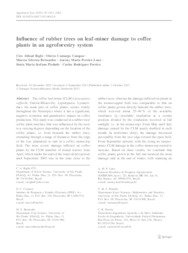Infuence of rubber trees on leaf-miner damage to coffee plants in an agroforestry system.
Infuence of rubber trees on leaf-miner damage to coffee plants in an agroforestry system.
Author(s): RIGHI, C. A.; CAMPOE, O. C.; BERNARDES, M. S.; LUNZ, A. M. P.; PIEDADE, S. M. S.; PEREIRA, C. R.
Summary: The coffee leaf-miner (CLM) (Leucoptera coffeella Guérin-Mèneville; Lepidoptera: Lyonetiidae), the main pest of coffee plants, occurs widely throughout the Neotropics where it has a significant, negative economic and quantitative impact on coffee production. This study was conducted in a rubber tree/coffee plant interface that was influenced by the trees to a varying degrees depending on the location of the coffee plants, i.e. from beneath the rubber trees, extending through a range of distances from the edge of the tree plantation to end in a coffee monocrop field. The most severe damage inflicted on coffee plants by the CLM (number of mined leaves) from April, which marks the start of the water deficit period, until September 2003 was in the zone close to the rubber trees, whereas the damage inflicted on plants in the monocropped field was comparable to that on coffee plants grown directly beneath the rubber trees, which received about 25-40 % of the available irradiance (Ir-available irradiation at a certain position divided by the irradiation received in full sunlight, i.e. in the monocrop). From May until July damage caused by the CLM nearly doubled in each month. In midwinter (July), the damage decreased perceptibly from the tree edge toward the open field. From September onward, with the rising air temperatures CLM damage in the coffee monocrop started to increase. Based on these results, we conclude that coffee plants grown in the full sun incurred the most damage only at the end of winter, with warming air temperatures. Coffee plants grown in shadier locations (25-40 % Ir) were less damaged by the CLM, although a higher proportion of their leaves were mined. The rubber trees probably acted as a shelter during the cold autumn and winter seasons, leading to greater CLM damage over a distance outside the rubber tree plantation that was about equal to the height of the trees. Future studies should attempt to relate leaf hydric potential to pest attack in field conditions. More rigorous measurements of shade conditions could improve our understanding of the relationship of this factor to CLM attack.
Publication year: 2013
Types of publication: Journal article
Unit: Embrapa Acre
Keywords: Agroforestería, Agroforestry, Agrossilvicultura, Bicho mineiro, Cafe, Caucho, Coffea arábica, Coffee, Consorciação de cultura, Continuous cropping, Cultivo Continuo, Cultivo mixto, Hevea, Leafminers, Leucoptera coffeella, Minador de las hojas, Mixed cropping, Monocultura, Performance, Perileucoptera Coffeella, Plagas de plantas, Plant pests, Praga de planta, Rubber tree, Seringueira, Shade agroforestry systems, Sistema Agroflorestal (SAF), Sistemas de sombra, Sombreamento
Observation
Some of Embrapa's publications are published as ePub files. To read them, use or download one of the following free software options to your computer or mobile device. Android: Google Play Books; IOS: iBooks; Windows and Linux: Calibre.
Access other publications
Access the Agricultural Research Database (BDPA) to consult Embrapa's full library collection and records.
Visit Embrapa Bookstore to purchase books and other publications sold by Embrapa.

